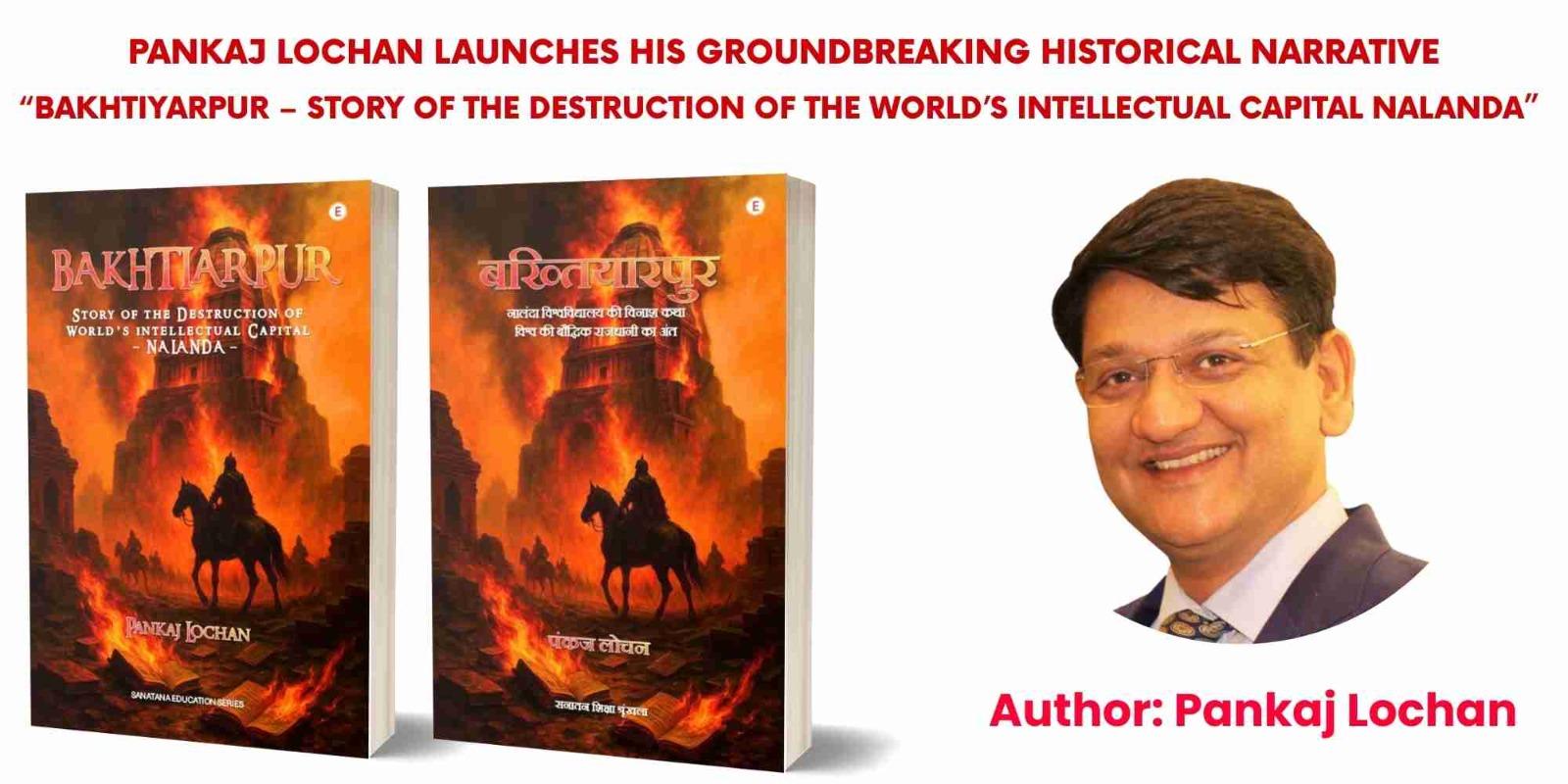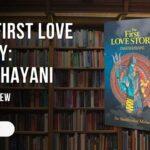
A tribute to Nalanda’s lost glory – Book review of Bakhtiyarpur.
Author: Pankaj Lochan
Publisher: Evincepub Publishing
ISBN: 9789363558342
Introduction
History is not just the record of kings, battles, and dynasties—it is also the story of ideas, of knowledge systems, and of civilizational memory. Pankaj Lochan’s book Bakhtiyarpur stands out because it explores not only the destruction of Nalanda University but also the deeper cultural amnesia that allowed this loss to be buried in silence. Subtitled Story of the Destruction of the World’s Intellectual Capital – Nalanda, the book is both a historical narrative and a deeply personal journey.
Published on the auspicious occasion of Sri Krishna Janmashtami in 2025, the book is a tribute to India’s forgotten intellectual heritage and a call for remembrance. Lochan writes not as an academic historian but as a sensitive seeker, weaving memoir, oral history, and reflection into a powerful exploration of identity, memory, and cultural survival.
Structure and Narrative
The book is structured over seven chapters, framed by a prologue and epilogue. What begins as an innocent childhood query gradually unfolds into a lifelong quest. The author recalls his return to his maternal village in Bihar in the 1980s, where a railway station signboard—Bakhtiyarpur—triggers unease. Why, he wonders, is a place named after Bakhtiyar Khilji, the man who destroyed Nalanda?
From this moment of curiosity, the narrative deepens into an exploration of history and cultural erasure. Lochan blends his personal journey with historical research, oral traditions, and philosophical questioning. Each chapter moves between memoir and meditation, personal memory and collective loss.
Themes and Insights
1. Memory, Identity, and Erasure
One of the strongest themes in Bakhtiyarpur is the idea of memory—what we choose to remember and what we forget. Lochan reflects on how names like Bakhtiyarpur have replaced older, culturally significant names such as Baikathpur, once associated with an ancient Shiva temple.
This erasure is not accidental; it is symbolic of a deeper cultural amnesia. The author mourns not only the destruction of Nalanda but also the silence that followed. Why do Indians continue to live under place names that honor their destroyers rather than their creators? Why is there no protest, no movement to reclaim memory?
Without preaching or bitterness, Lochan poses these difficult questions. His critique is directed not at a community or religion but at the societal indifference that allowed civilizational memory to fade.
2. Oral Traditions as Custodians of Truth
The book highlights the importance of oral traditions. Much of the knowledge the author gathers comes not from history textbooks but from elders—schoolteachers, villagers, and his own relatives. These voices, often dismissed in formal history, preserve memories that institutional narratives ignore.
For example, the figure of Guruji, the elderly teacher at the railway platform, emerges as a central character. His wisdom, humility, and lived experience carry more historical truth than official curricula. Lochan treats such custodians of memory with reverence, acknowledging their role in keeping the past alive.
3. The Lost Glory of Nalanda
At the heart of the book lies the story of Nalanda University, one of the greatest centers of learning in the ancient world. Founded in the 5th century CE, Nalanda attracted scholars from across Asia. It housed millions of manuscripts and produced intellectual giants in philosophy, mathematics, astronomy, medicine, and logic.
Its destruction in 1193 CE, allegedly at the hands of Bakhtiyar Khilji, was catastrophic. Lochan compares Nalanda to the Harvard, NASA, and Silicon Valley of its time. The burning of nine million manuscripts, the killing of thousands of monks, and the annihilation of a civilizational way of thinking constituted nothing less than cultural genocide.
Yet, Lochan insists the story is not about anger but about remembrance. Pain must lead to resolve, not hatred. This distinction is crucial and gives the book its emotional maturity.
4. Critique of the Education System
A recurring theme in the book is the failure of India’s education system. Lochan argues that school textbooks have sidelined important empires and figures such as Raja Bhoj, Rani Durgavati, Ahilyabai Holkar, and the Cholas, while failing to highlight India’s great intellectuals like Nagarjuna, Aryabhata, and Charaka.
Why are Indian children not taught about their intellectual ancestors? Why does the curriculum continue to emphasize colonial or foreign narratives while neglecting India’s own contributions to world knowledge? These questions form the backbone of Lochan’s cultural critique.
5. Cultural Critique without Jingoism
What makes Bakhtiyarpur unique is its tone. The book does not indulge in rhetoric or communal blame. Instead, it asks reflective questions:
- Why do we name towns after invaders instead of saints and scholars?
- Why do textbooks omit key historical truths?
- How did India allow its intellectual heritage to be overwritten without protest?
By framing these questions as cultural self-reflection, Lochan avoids falling into the trap of jingoism. His critique is not about division but about awareness, dignity, and truth.
Literary Style and Storytelling
Lochan’s writing is poetic and layered. He moves fluidly between nostalgia, history, and philosophical reflection. Early chapters capture the innocence of childhood—village life, temple bells, grandmother’s stories. Later chapters become more intense, exploring the brutal destruction of libraries and the haunting silence of erasure.
The prose mirrors the author’s journey—from innocence to confusion, from pain to resolve. Short, crisp sentences express bewilderment, while lyrical passages convey beauty or grief. The rhythm of the writing keeps readers engaged, making the book accessible even while tackling profound subjects.
Relevance in Modern India
The questions Lochan raises are deeply relevant today. As India debates curriculum reforms, place renaming, and cultural representation, Bakhtiyarpur provides a thoughtful roadmap. It does not call for erasing the past but for confronting it honestly.
The book suggests that remembrance is not about vengeance but about reclaiming pride. To rebuild India’s intellectual confidence, society must acknowledge both its past glories and its tragedies. Lochan’s work is both a wake-up call and a healing balm.
Emotional and Personal Resonance
What sets this book apart from academic history is its emotional resonance. Lochan is not writing as a detached historian but as a seeker. The narrative is deeply personal—rooted in his own childhood memories, questions, and frustrations.
The reader can feel the ache of a boy who asks, “Why is it called Bakhtiyarpur?” and never receives an answer from teachers or textbooks. That confusion becomes a metaphor for India’s larger silence about its own heritage.
This emotional authenticity makes the book relatable. Readers may find their own frustrations mirrored in the author’s journey.
Minor Criticisms
While powerful, the book has some limitations:
- The deeply personal tone may not appeal to readers seeking an academic or detached account.
- The narrative could have benefited from comparative global examples—how other nations have reclaimed erased histories through renaming and cultural revival.
- At times, emotional intensity overshadows historical detail.
However, these are minor flaws in an otherwise compelling and necessary work.
About the Author – Pankaj Lochan
Pankaj Lochan is a distinguished corporate leader, thinker, and author of twelve books. An alumnus of IIT-BHU (Mechanical Engineering) and IIM Ahmedabad, he has held senior leadership roles in Tata Steel, Dr. Reddy’s Laboratories, JSW Group, Ambuja Cements, Jindal Steel & Power, and the Mafatlal Group.
His writing spans across leadership, management, Total Quality Management (TQM), cultural reflection, and historical narrative. Known for his seven-book TQM series on operational excellence, Lochan brings the same rigor and insight to history that he brings to management. His Sanatana Education Series seeks to rediscover India’s civilizational roots. Bakhtiyarpur marks the second book in this series, following Sanatan and Science.
Conclusion
Pankaj Lochan’s Bakhtiyarpur is more than a history book—it is a meditation on identity, memory, and cultural pride. By intertwining memoir, oral history, and civilizational critique, Lochan brings alive the tragedy of Nalanda while urging readers to reflect on the present.
The book is not about blame but about awakening. It is about asking why we forget, and how we might remember. Lochan whispers, but his whispers echo louder than most slogans.
For students, educators, historians, and patriots, this book is essential reading. It is a reminder that Nalanda was not just India’s treasure but the world’s intellectual capital, and its destruction must never be forgotten. This book is available in Hindi and English both languages.
Verdict: Bakhtiyarpur is a powerful blend of memoir, history, and cultural commentary. It is a heartfelt tribute to Nalanda and a call to reclaim India’s intellectual heritage. Highly recommended.

